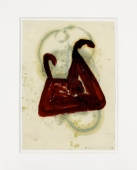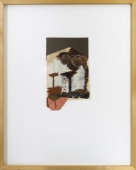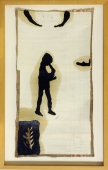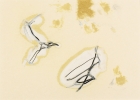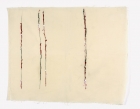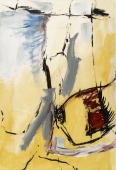
Artist | Mathias Völcker (*1955)
https://www.artist-info.com/artist/Mathias-Voelcker
Biography
Biography
born in Rostock in 1955
About the work (english)
About the work (english)
Drawings and „taut wall drawings“
The window of his studio offers a superb view over Frankfurt by night: a sea of houses and apartment blocks, all of which, once you have let your eyes be sensitized by Mathias Völcker's work, resemble gigantic jaws und appear to have eyes that stare out at you threateningly. You feel that you are seeing faces everywhere. The dividing line between architecture and human being starts to become fluid, things seemingly assume anthropomorphic properties and with them an organic life of their own. Your eyes and mind are set in motion - what you have often seen before on an miniature scale as fine pencil lines or brush strokes now becomes projection of your mind's eye.
Mathias Völcker has a wealth of drawings stored away in his studio and they cover a surprisingly wide range of different motifs and formal approaches. The variety of the material may at first sight be confusing, but after a closer look at the individual works they merge ever more into a unity, condensing to a powerful artistic ability to portray in such a manner as to fascinate such that they grip your gaze. Tender outline drawings, sometimes reduced to the limits of what is visually perceivable stand alongside overdrawn, strongly concentrated motifs. In some of the drawings, faces emerge out of the murky depths of the background almost as if they were part of some picture puzzle. Others have a soft, flowing feel about them, as tender as Japanese ink drawings. There are others, yet again, which have the appearance of woodcuts, for the outlines of the figures seem to be hewn coarsely. And repeatedly you also come across clearly structured drawings which underline Völcker's interest in architecture.
Mathias Völcker "builds" houses and huge factory like apartment blocks, changing them playfully until they take on human features. What arises are houses that have faces, which appear to crawl along the ground, and others which are apparently cruciform - a person lying on the ground arms completely outstretched, frozen into the blocks of apartment buildings. Völcker is continually transforming architecture into anthropomorphic shapes, and, conversely, the constructive thrust of architecture become the agent of psychological expression.
Even in those instances where Völcker undermines the threatening character of his motifs by incorporating comic-likefeatures and thus encourages us to chuckle at his drawings, they nevertheless make us pause for thought. His oeuvre concentrates an two different worlds colliding namely, inner and external reality. The fomer is governed by disorder, by an element off lux that is often dominated by chaos, whereas the latter is ruled by the principle of order, an order that is, however, forever being shattered and suspended. Yet the external world offers a framework which dons the „face“ of its inner counterpart all the same.
What characterizes Völcker's works is a moment of movement, often alluded to by the saturnine structuring of the visual elements. Like planets, hats and heads circle in an ever unchanging orbit. Everything appears to float, and yet, nevertheless, is not without some anchoring - even the emptiness in some of the drawings creates tension. Sometimes it is colour which is used as a link. Or small squares that are positioned in the corners function as fixed points as if the paper were already pinned to the wall.
In his drawings, Mathias Völcker renders various forces visible. They are given outward form in the skape of demonic grimaces: ask-like and symbolic. Even if the observer is occasionally reminded of traditional Japanese motifs, Völcker constantly reveals that he is our contemporary. Each of his drawings emphasizes where he stands and how he sees the world. In this context, titles would merely be a source of irritation. And he thus forgoes relying on even the "Untitled" to which some artists resort. at is not present compels you to study the drawings closely.
Mathias Völcker said that simply because he went to an anthroposophical school as a child by no means made him a follower of that movement. Yet what it did do was give him a holistic approach, and many of his works consequently draw their vitality from a combination of differing or opposite aspects.
Ever since 1984 he has, with his taut wall drawings, referred to real space: fine lines spanned with thin threads across the face of the wall, lines which, depending on the angle of the light, create tender shadows and thus turn two-dimensional surfaces into three-dimensional structures.
His Windlinhaus book project, which he recently completed, contains the quintessence of his work over the last ten years - here, photographs which served him predominantly as documentation are juxtaposed for the first time to drawings. The result is a "picture book" which invites you to take it in your hands, look at it and read it. The world as one single Mickey Mouse.
*About the work (deutsch): Zeichnungen und „Wandspannzeichnungen“
Von seinem Atelierfenster aus hat man einen herrlichen Blick auf das nächtliche Frankfurt. Ein Meer von Häusern und Wohnblocks, die alle, ist man einmal durch die Arbeiten von Mathias Völcker dafür sensibilisiert, riesige Schlünde und bedrohlich nach außen tretende Augen zu haben scheinen. Überall meint man Gesichter zu sehen. Die Grenze zwischen Architektur und Mensch beginnt zu zerfließen, Dinge werden scheinbar anthropomorph und erhalten ein organisches Eigenleben. Auge und Geist geraten in Bewegung, und das, was man zuvor oftmals auf kleinstem Format in feinen Bleistift- oder Pinselstrichen gesehen hat, wird zur eigenen Projektion.
Mathias Völcker hat in seinem Atelier eine Vielzahl von Zeichnungen gelagert, die eine überraschende Spannbreite an Motiven und formalen Gestaltungsmöglichkeiten bieten. Die Vielfalt des Materials verwirrt, fügt sich dann aber beim Sichten der einzelnen Arbeiten mehr und mehr zusammen und verdichtet sich zu einem bildnerischen Kräftepotential, das das Auge magisch bindet. Zarte Umrißzeichnungen, manchmal bis an die Grenze des visuell Wahrnehmbaren reduziert, stehen neben überzeichneten, stark komprimierten Motiven. In einigen Blättern treten aus dem Dunkel des Hintergrundes, Vexierbildern gleich, Gesichter hervor. In anderen, zart Wie japanische Tuschezeichnungen, ist der Duktus weich und fließend. Wieder andere erinnern an Holzchnitte, in ihnen scheinen die Umrißlinien der Figuren grob herausgeschnitten zu sein. Daneben tauchen immer wieder klar strukturierte Zeichnungen auf, die das Interesse des Künstlers an architektonischen Prinzipien verdeutlichen.
Mathias Völcker "baut" Häuser und riesige Wohnfabriken, die er spielerisch verfremdet, bis sie menschliche Züge annehmen: Häuser, die Gesichter tragen, die am Boden zu kriechen scheinen, andere, die an Kreuzformen erinnern - der mit weit auseinandergebreiteten Armen auf dem Boden liegende Mensch, eingefroren in einer Blockform aus Wohnhäusern. Immer wieder wird die Architektur in eine anthropomorphe Form transformiert und umgekehrt wird das konstruktive Element der Architektur zum Träger psychischer Ausdrucksmomente.
Auch dann, wenn Mathias Völcker die Bedrohlichkeit seiner Motive durch comicartige Elemente bricht, mit seinen Zeichnungen zum Schmunzeln anregt, nachdenklich stimmen sie immer. Sein Schaffen konzentriert sich auf die Auseinandersetzung mit zwei Welten, einer inneren und einer äußeren Realität. Die innere ist die der Unordnung, das fließende, oftmals vom Chaos beherrschte Moment, die äußere Welt ist gekennzeichnet durch das Prinzip der Ordnung, das jedoch immer wieder durchdrungen und durchbrochen wird. Zwar bietet sie - die äußere Welt - einen Rahmen, der dann doch das "Gesicht" der inneren trägt.
Was die Arbeiten des Künstlers vor allem charakterisiert, ist das Moment der Bewegung, nicht selten in der saturnartigen Anordnung der Bildelemente angedeutet. Hüte und Köpfe kreisen gleich Planeten in einer immer gleichbleibenden Umlaufbahn. Alles scheint zu schweben und ist doch nicht ohne Halt, selbst die Leere in manchen Zeichnungen erzeugt Spannung. Manchmal ist es die Farbe, die bindet. Oder kleine, jeweils in den Bildecken angeordnete Quadrate werden zu Fixpunkten, als wäre das Blatt bereits an der Wand befestigt.
Mathias Völcker macht in seinen Zeichnungen Kräfte sichtbar. In dämonischen Fratzen, maskenartig und symbolhaft, gewinnen sie eine äußere Form. Auch wenn sich der Betrachter teilweise an traditionelle spanische Motivwelten erinnert fühlt, seine Zeitgenossenschaft gibt der Künstler immer zu erkennen. Jede seiner Zeichnungen macht deutlich, wo er steht, wie er Welt sieht. Titel würden hier nur irritieren. Selbst die von anderen Künstlern oft gewählte Bezeichnung "Ohne Titel" entfällt. Das Nichtvorhandene zwingt zum genaueren Hinschauen.
Der Besuch der Waldorfschule habe ihn noch nicht zu einem Anthroposophen gemacht, sagt Mathias Völcker. Die Erkenntnis der Ganzheitlichkeit war es jedoch, die in ihm zum Tragen kam, und so leben viele seiner Arbeiten von der Verbindung unterschiedlicher oder gegensätzlicher Aspekte. In den Wandspannzeichnungen, seit dem Jahr 1984, bezieht er sich auch auf den realen Raum: Feine, mit dünnen Fäden an der Wand entlanggespannte Linien, die je nach Lichteinfall zarte Schatten werfen und dadurch Flächengebilde zu plastischen Körpern werden lassen.
Mit seinem jüngst abgeschlossenen Buchprojekt Windlinhaus zieht er eine Art Quintessenz aus der Arbeit der letzten zehn Jahre. Fotografien, die ihm zuvor überwiegend zur Dokumentation dienten, werden hier erstmals Zeichnungen gegenübergestellt. Entstanden ist ein "Bilderbuch", das zum in die Hand nehmen auffordert, das betrachtet und gelesen werden will. - Der Globus als eine einzige Mickey Mouse.
German text by Susanne Lange / Translation by Jeremy Gaines
(Extract - Full printed version available in the Museum)
MMK - Museum für Moderne Kunst, Frankfurt am Main
 offers / Requests offers / Requests  |
About this service |
|---|
 Exhibition Announcements Exhibition Announcements  |
About this service |
|---|
 Visualization |
Learn more about this service | ||
|---|---|---|---|

Interested in discovering more of this artist's networks?
3 easy steps: Register, buy a package for a visualization, select the artist.
See examples how visualization looks like for an artist, a curator, or an exhibition place: Gallery, museum, non-profit place, or collector.

Exhibition History

|
SUMMARY based on artist-info records. More details and Visualizing Art Networks on demand. Venue types: Gallery / Museum / Non-Profit / Collector |
||||||||||||
| Exhibitions in artist-info | 19 (S 6/ G 13) |
Did show together with - Top 5 of 286 artists (no. of shows) - all shows - Top 100
|
||||||||||
| Exhibitions by type | 19: 11 / 3 / 4 / 1 | |||||||||||
| Venues by type | 11: 4 / 2 / 4 / 1 | |||||||||||
| Curators | 3 | |||||||||||
| artist-info records | Oct 1982 - Apr 2015 | |||||||||||
|
Countries - Top 2 of 2 Germany (14) United States (1) |
Cities 3 - Top of 3 Frankfurt am Main (10) Düsseldorf (8) New York (1) |
Venues (no. of shows )
Top 5 of 11
|
||||||||||
Curators (no. of shows)
Top 3 of 3
|
| Deutsche Bank Collection - Artists | S | Apr 2015 - Apr 2015 | Frankfurt am Main | (1) | +0 | |
| Galerie Ute Parduhn | G | Nov 2014 - Jan 2015 | Düsseldorf | (159) | +0 | |
| Galerie Ute Parduhn | G | Feb 2013 - Apr 2013 | Düsseldorf | (159) | +0 | |
| ATELIERFRANKFURT | G | Nov 2012 - Jan 2013 | Frankfurt am Main | (62) | +0 | |
| Mayer, Corinna (Curator) | +0 | |||||
| Galerie Ute Parduhn | S | Nov 1996 - Dec 1996 | Düsseldorf | (159) | +0 | |
| Whitney Museum of American Art | G | Oct 1996 - Jan 1997 | New York | (365) | +0 | |
| Ammann, Jean-Christophe (Curator) | +0 | |||||
| Weinberg, Adam D. (Curator) | +0 | |||||
| Keep reading |















